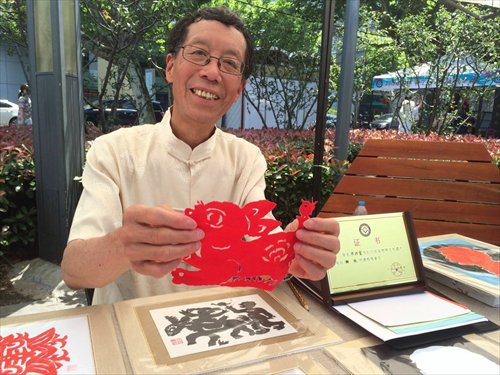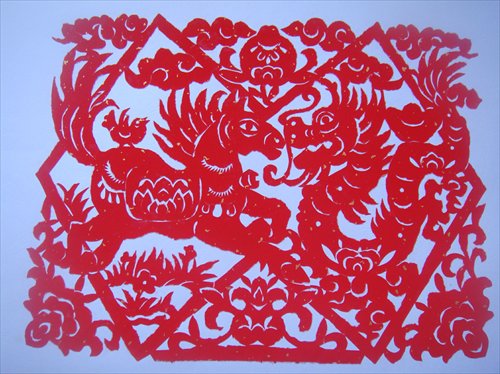The art of paper tearing
Local artist Hua Xingfu keeps this ancient folk form alive
Without scissors or blades, a sheet of white paper is torn into a lovely rabbit in less than a minute. The simple, rough outline and the plan profile of the rabbit are quite different from a pattern cut with scissors.
Paper tearing is lesser-known art, but it has a profound history embodying simplicity and folk culture.
An exhibition featuring paper tearing work by Shanghai-based folk artist Hua Xingfu (pictured below) is on display at Shanghai Hongqiao Contemporary Art Museum from now until September 3. The Global Times recently spoke with Hua about his life as an inheritor of this ancient art form.

Art at your fingertips
Hua said that paper tearing is the oldest form of paper art - other forms include paper cutting and paper carving. Before the tools for these more complicated arts were invented, our ancestors were already tearing bark, leaves and fish skin with their hands to make clothes to keep warm.
Paper tearing is characterized by its simple patterns, dynamic flow and creativity, according to Hua.
With his deep artistic experience and acute hands, Hua can tear a piece of paper into mountains, flowers, people, animals, fish and insects within seconds.
Although there is not much detail to these designs, the rough margins of the torn paper have an original beauty.
Hua deals most with the theme of Chinese horoscopes. Every year he creates about 100 pieces depicting the animal of the year.
In the Year of the Rat, for example, he created a piece featuring 10 rats whose tails are tangled together. A baby rat leans close to its mother if they were talking intimately. Usually in his horoscope works Hua will also add some traditional Chinese auspicious symbols, such as the bowl (which means prosperity), the propitious cloud or the representative flowers of the seasons. All of these patterns are torn from a single piece of paper.
Creating such complicated patterns require a lot of practice. "Many people can tear paper, but few can stick to this art as I do," said Hua, who has practiced paper tearing for over 40 years.
Since the paper is folded many times, it requires great strength in the thumb and index finger.
Because he creates so many complex pieces, Hua has recurring pain in his fingers and nails. The joints of his thumbs are also out of shape due to years of work; the tip of his thumb has morphed into the shape of a triangle.
"My thumbs are like two sharp knives," said Hua, who used to do push-ups with his thumbs and index fingers to build up the muscle.
Hua's story with paper tearing begins decades ago, when he was a child.
"I saw a folk artist tear paper in a museum," Hua said. "I was totally shocked that he managed to tear characters and all kinds of patterns without tools. Since in the past, scissors were not as accessible as they are today, I was deeply attracted to this interesting, money-saving art."
Coincidentally, he got a job in a printing house, which gave him access to different kinds of paper and allowed him to begin practicing paper tearing.
"I worked with paper everyday, and I know how much processing it takes to create a piece of paper. Now I am reluctant to throw away any paper, even the advertisements stuffed in my mailboxes," said Hua.
He has been collecting paper for 40 years and has six wardrobes filled with different varieties. These calendar papers, old magazines and newspapers are now the raw material for his art.
"I make full use of them," said Hua. "I use different patterns based on the different material I have."
In one work, he created two lively fish using posters from the supermarket. Patterns of the corn printed on the paper resemble the fish's scales.

A piece of paper tearing artwork by Hua Xingfu Photos: Courtesy of Shanghai Hongqiao Contemporary Art Museum
Spreading awareness
Currently Hua has an apprentice, but this folk art is still in danger of extinction. Hua's biggest preoccupation is expanding people's awareness of paper tearing, so that they can experience its joy and simplicity for themselves.
During the Word Expo 2010 in Shanghai, Hua volunteered to showcase his skills to the public by tearing a profile of some Expo visitors.
Every week, he teaches a class in a primary school, and this summer he is teaching children the basic skills of paper tearing in a community school in Changning district. He starts with simple patterns such as the rabbit and the fish.
"The children love tearing paper with me. In my class there is no unsuccessful work. Even if you make a wrong stroke, you can always find a remedy using your imagination. This is what I always tell the children. By tearing the rabbit's long ears into a triangle, you have a cat. If you tear the mouth a little wide, you have a tiger. It is so much fun," said Hua.
"In paper tearing, all the complicated shapes are derived from three basic elements: the moon shape, the circle and the lines. All you have to do is have your eyes, hands and mind work in harmony."
Hua's 10-year-old granddaughter is also interested in the art. "She still has lots to learn," said Hua, "but I'm glad she loves this art."
Hua's next idea is to try tearing buttonwood leaves. "The fallen leaves have a beautiful color and texture," he said. "I want to go back to the past and imitate the way our ancestors tore leaves."